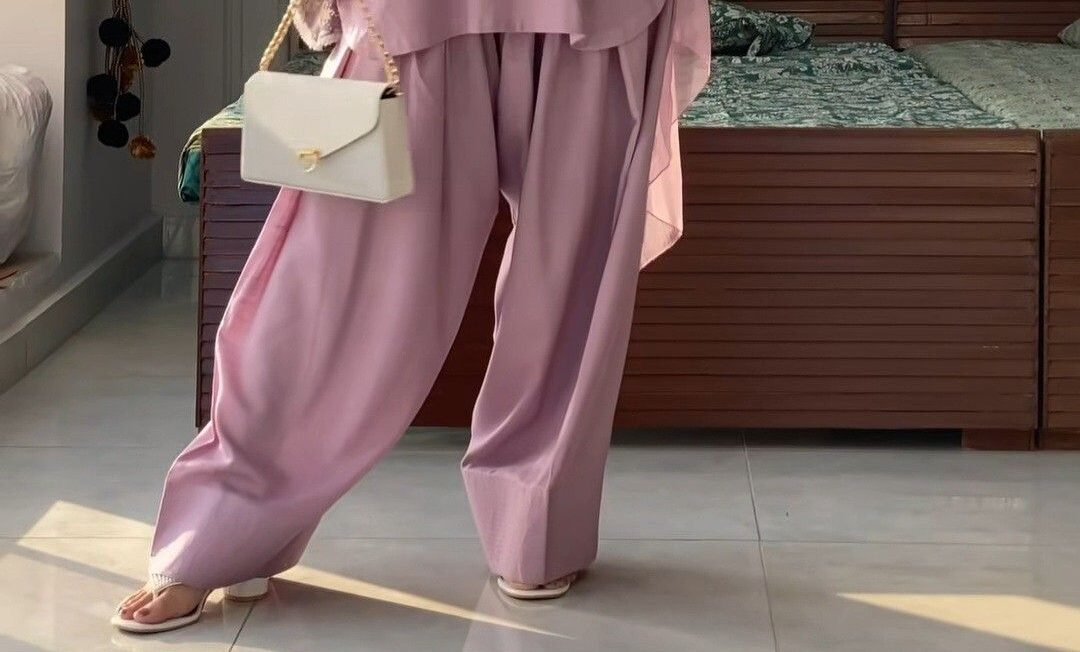A Wedding in Clarksburg
A few months ago, I attended a family wedding in Clarksburg, Maryland. It was the usual scene. Glittering lehengas. Sequined gowns. The same modern look you see at almost every event. But then, something different. One of the bridesmaids walked in wearing a Farshi Shalwar. It swept across the floor with each step, quiet but commanding. People noticed. Older women smiled knowingly. Younger guests pulled out phones. I remember thinking, Wow, that’s history showing up in a banquet hall.

The Farshi Shalwar isn’t new. It’s old. Older than most of us can even imagine. Yet it felt fresh that night. Almost rebellious.
farshi
What Makes It Different
So what exactly is this thing? The Farshi Shalwar is basically a lower garment. But not the kind you wear casually at home. It’s wide. Really wide. The word farshi literally means “of the floor,” and that’s exactly what it does, it trails. Traditionally, it takes about 9 to 15 yards of fabric to stitch just one. That’s a lot of cloth.
It’s usually paired with a long kameez and a dupatta. Embroidery is particularly noticeable at the hem, where the fabric brushes against the ground. Gold thread. Gota. Sometimes zardozi. Basically, the kind of work that takes weeks. Unlike a churidar, this is not made for speed or convenience. It’s designed to impress.
A Bit of History
The Farshi Shalwar first became famous in the Mughal courts. Women wore them while walking across marble floors, and the fabric spread out like a painting. Back then, jamawar, silk, velvet—these were the choices. Artisans added embellishments that turned fabric into heritage.

It didn’t disappear after the Mughal era. During the 1960s and 1970s, the garment resurfaced, this time on television and film. Actresses carried it with pride. Even my grandmother, who married in 1971, told me she wore one for her wedding. She laughed as she described how heavy it felt. “Like carrying a rug,” she said, “but so beautiful I didn’t care.” That’s the thing about cultural fashion it carries memory, not just fabric.
Fashion and Money
Now let’s step back. Why does this revival matter? Pakistan’s fashion market is massive. According to ProPakistani, it’s worth around 10 billion dollars in 2025. The textile industry itself employs approximately 25 million people, accounting for 8.5 percent of the GDP.
When designers revive old styles, it’s not just nostalgia. It’s economics. Every Farshi Shalwar produced supports embroidery workers, dyers, and small family workshops. In a world obsessed with “fast fashion,” Pakistan’s revival of the Farshi is actually an example of slow fashion—pieces that last, tell a story, and employ real hands.
Why It’s Trending Now
Let’s be honest. Not everything comes back. Some trends are gone forever. But the Farshi Shalwar is different. It’s resurfacing due to three key factors.
- Social media. Instagram and TikTok are full of wedding videos tagged #FarshiShalwar and #PakistaniFashion. A new generation is discovering the style by scrolling.
- Celebrities. Models like Sadaf Kanwal have worn it in bridal shoots. Designers showcase it at fashion weeks. People copy what they see.
- Diaspora pride. For families in places like Maryland or New York, wearing something like this is more than just a matter of style. Its identity. It says, “Yes, I live here, but my roots matter.”
And let’s not forget weddings. As per Dawn Pakistan’s wedding industry is valued at over 3.5 billion dollars annually. With that kind of money floating around, everyone wants to stand out. The Farshi Shalwar is perfect for that.
How People Are Wearing It Today
The Farshi of today isn’t always the same as what queens wore. Designers have adjusted. Here’s how:
- Bridal wear: heavy silks, velvets, kameez down to the ankles, embroidery that shines under wedding lights.
- Eid outfits: lighter chiffons, pastel shades, softer threadwork. Comfortable enough for visiting relatives, still elegant.
- Formal dinners: plain silks paired with a minimal shirt. Stylish but not overwhelming.
- Experimentation: yes, even Farshi Shalwars made of cotton exist now. Imagine pairing it with a short kurta. Casual, almost quirky.
Practical? Not always. If you’re rushing for the Metro in DC, it might be a nightmare. But that’s not the point. This garment isn’t for rushing. It’s for pausing, for showing.
Global Access, Local Pride
Here in Clarksburg, women can order authentic designs without waiting weeks for packages from Pakistan. It’s faster, easier, and safer. Check out our curated Collection for outfits that celebrate tradition while fitting into today’s world.
This access matters. It allows younger people abroad to connect with their heritage in a real, physical way. Not just stories or pictures, but actual fabric that ties them to home.
More Than Just Fashion
Let’s be clear. Wearing a Farshi Shalwar today is not just about looking good. It’s about carrying culture. In an era when global trends homogenize differences, choosing traditional garments is a way of saying, “I know who I am.”
It also helps artisans. According to UNESCO, many traditional crafts around the world are disappearing as younger generations move to different work. Buying and wearing these garments keeps those skills alive. It’s heritage preservation you can actually wear.
Closing Thoughts
That night in Clarksburg, as music played and guests danced, the Farshi Shalwar stood out. It wasn’t louder than the gowns or brighter than the lehengas, but it carried something they didn’t have in history. It reminded everyone in the room that fashion can be more than seasonal trends. It can be memory, identity, or even pride stitched into fabric.
Fashion evolves. Styles shift. But some garments never truly leave. They wait. And when the world is ready, they return. The Farshi Shalwar is one of those garments.
So the next time you’re dressing for Eid or planning your outfit for a wedding, consider this. Why not wear something that tells a story centuries old, yet still feels right today? Sometimes the past isn’t behind us. Sometimes it’s right there, waiting in your closet.


